The Smartest Girl in the World Play Guide

What to know – before the show!
[bs_collapse id=”collapse_7a33-e80d”]
[bs_citem title=”Play Synopsis” id=”citem_0349-7490″ parent=”collapse_7a33-e80d”]
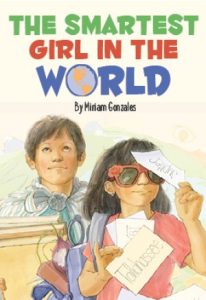
The story begins with Lizzy, a second grader, playing with her older brother Leo and their cousin Hector. Leo has written a script for them to perform, but Hector would rather play something else, and Lizzy’s imaginative nature is cramping Leo’s more factual style. Their play is interrupted by Mami, who comes in to remind Leo to take his medicine and to tell him he is in charge of taking care of Lizzy. Leo then announces that he must study for ‘The Challenge’ tryouts, a TV quiz show.
Later, Lizzy and Leo study together, but Lizzy struggles to answer any question correctly. Leo tells her that they must be “Einstein smart” so they can get well-paying jobs and take their family on vacations when they grow up, a plan to which Lizzy agrees. A car backfiring nearby scares Lizzy leading Leo to comfort his little sister by putting on a cape to become the hero “Kotar.” He tells tales of Kotar’s many adventures as Lizzy falls asleep.
The next day, Lizzy and her friend Cheryl are playing when Hector rushes in to tell them that Leo made it onto The Challenge. The good news is cut short, however, by the sounds of Leo arguing with Mami and Papi. Leo enters the room, upset and crying, and tells Lizzy that they won’t let him go on The Challenge because he is too sick. When Lizzy attempts to comfort her brother, he lashes out and tears up the Kotar cape.
Later that night, their Aunt Kid comes to visit and finds Lizzy upset in the closet. Lizzy tells her about “The Plan” and asks about how sick Leo is. Aunt Kid tells her that Leo has Sickle Cell Anemia but assures her that the doctors and her parents know what to do. Lizzy then comes up with the idea to become the smartest girl in the world so that she can go on The Challenge and keep “The Plan” going.
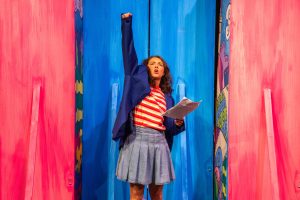
Lizzy spends her summer leading into third grade studying constantly. One day, Leo comes home with Hector and the two discuss how Coach Bumford made fun of Leo for being sick in front of everyone. Leo expresses frustration with his illness and Hector suggests that he run for Student Council President, since it wouldn’t be as physically taxing. The next day, Lizzy and Cheryl enter their room celebrating because Lizzy made it onto The Challenge. But Leo doesn’t take the news well and vows not to speak to Lizzy again. Lizzy goes to her Aunt Kid for advice and explains what’s going on. She tells Lizzy about a family that once became incredibly successful, but their success tore the family apart. She encourages Lizzy to remember that the most important thing is love. Lizzy comes back to her room where she finds Leo preparing for his Student Council President race. He gets upset that his plan is found out and makes Lizzy promise not to tell Mami and Papi.
The day of The Challenge finally arrives. Lizzy does very well but ultimately loses. She returns home to find her brother missing, but he soon returns with a treat for her. He tells her that he watched her on The Challenge and that she did a good job. Lizzy offers to help Leo practice telling Mami and Papi about the Student Council election. She then gives him back the Kotar cape that she has fixed, and the two reconcile. [/bs_citem]
[bs_citem title=”Play Before the Play” id=”citem_3feb-26be” parent=”collapse_7a33-e80d”]
CLASS QUIZ SHOW

The Smartest Girl in the World features a fictional televised quiz show. In your class, have your students create a quiz show of their own! Split the class into small groups and inform them that each group will be creating a quiz show. Each group’s quiz show should have the following:
- A theme (general trivia, history, pop culture, etc.)
- A logo/title card
- A theme song/theme music
Once students have settled on a theme for their show, they should work to create at least 5 categories and a series of 5-10 questions for each with the correct answer listed for each. As students work, encourage them to be creative in their choice of categories and questions. They can even add a wacky twist to their quiz show. Then have the groups assign a host for their show. Once each group is ready, have them take turns doing a small segment from each quiz show. Have the members from the other groups act as the teams while the rest of the class acts as the live studio audience.
After each group has gone, have a discussion as a class about their creation process. Were there any similarities between each group’s themes? Were there any categories or questions that were harder or easier than others? What were some challenges that the groups faced as they put their show together?
KAS: TH:Pr6.1.4.; TH:Re7.1.4.
THE PLAN
Lizzy and Leo are a loving sibling duo in The Smartest Girl in the World. They create “The Plan” to become incredibly smart so that they can grow up, get successful, well-paying jobs, and go on vacation with their family to Hawai’i. Before going to see the show, give your students the opportunity to create their own plans. Have students write a letter to their future selves outlining their plan. If students need inspiration, have them consider the following questions:
- What kind of jobs do they want to have when they grow up?
- Where would they like to live?
- What are their dream vacation destinations?
- Will they want any pets?
After students have written out their plans, store them in an envelope until the end of the school year. At the end of the year, hand each student their letters and have them read. If they are feeling brave, they can share their letters with their peers and compare and contrast their answers. Then have a discussion with your students. Do they still want to follow through with their plans? Have they discovered a new area of interest during the school year that they may want to pursue in their future instead? What would they change or keep the same? Make sure to celebrate the individuality of each student. Remind them that everyone is their own unique person with their own unique goals, and that is amazing!
KAS: C.4.3; TH:Cn10.1.5
[/bs_citem]
[bs_citem title=”Contextual Article” id=”citem_20ae-b289″ parent=”collapse_7a33-e80d”]
ON THE ROAD: STAGING A TOURING PRODUCTION
The creation of Lexington Children’s Theatre’s production of The Smartest Girl in the World is a story of wits and heart all of its own. From choosing the script and casting actors to rehearsals and bringing all the designs to life, a great deal of time, preparation, and imagination goes into the realization of any theatre performance. What makes this production so special is that it tours. The actors pack everything needed for their performance and travel with it throughout the state of Kentucky and beyond. Keep reading to find out what it takes to get a stage production out on the road!
A production begins by reading and choosing scripts. The staff at Lexington Children’s Theatre goes through a series of Season Planning meetings in which they talk through what kinds of stories they’d be excited to tell. Staff members pitch show titles that the theatre might want to produce. They have to take into consideration many key factors such as target audience, budget and time constraints, cast and staffing requirements, and more. The Artistic Director then gathers what are called perusal scripts – copies of the play used to preview the story – and sends them out to the staff to read. From there, the staff discusses the scripts and narrows their choices down until they finally have a complete season. The process of choosing scripts begins at least a year in advance and can take several months to complete.
In the case of The Smartest Girl in the World, the staff at LCT chose the script way back in summer 2022 even though the show didn’t get to perform until fall 2023. The story excited the staff because of the themes of family and the love Lizzy and Leo have for each other. Lizzy and Leo share a strong bond, and as the story unfolds, we see just how much they are willing to step up to support one another despite the challenges life throws at them.
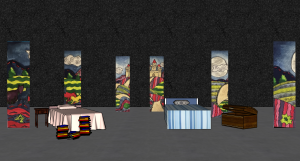
After a show title is chosen, it will move into the design process. This is when the artistic team meets to envision the world of the play. The director of the production collaborates with the designers in each of the technical areas (scenery, costumes, props, lights, sound, etc.) to figure out how things should look. The designers complete research and incorporate the director’s ideas with their own to create sketches, renderings, and models for all of the technical elements. The process begins at least three months before a show begins rehearsals and usually takes several weeks to complete, but once the director gives their final stamp of approval on the designs, the artistic team can begin construction on their elements.
For a touring production, everything needed to tell the story must be portable. This means that the actors must be able to break things down or store items away. Everything must fit into a truck that the actors pack, much like a game of Tetris. They then drive the truck to their next performance venue, unload everything to set it up, perform the show, break it down, load it back into the truck, and head to the next location.
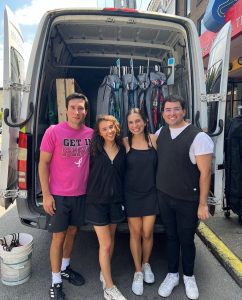
Speaking of actors, how is the show cast? LCT’s Resident Director and Company Manager is responsible for casting the actors you see in the company’s professional touring productions. The Resident Director often travels to conferences just to meet with actors wanting to audition for the company or watches audition tapes submitted online. When a show title is selected, the Resident Director makes note of the show’s casting needs including how many actors are required and other specifics such as race/ethnicity or gender. An audition or casting notice is sent out letting actors know that we are searching for actors for a show, and actors who are interested submit their materials to the theatre for review. Once the show is cast, the actors will come in anywhere from 3-8 weeks before a production opens or begins its run to start rehearsals.
In a touring production like Smartest Girl, the script calls for just four actors to play all the characters. The actors will often go in and out of character at a moment’s notice – sometimes without even changing costume pieces. It’s up to the actors, with help from the director, to physically and vocally differentiate the characters they play. Characters also have a costume piece or prop to help the audience recognize who they are. The actors spend several hours in rehearsal each day working out their blocking (where they move onstage), memorizing lines, tracking where costumes, props, and scenery pieces go, and more. After weeks of rehearsal, it’s finally time for the show to open!
The performance audiences get to see is the product of months and months of hard work. It takes about an hour of rehearsal for every minute of action you see onstage. A fully realized production takes dozens of individuals working together to bring a story to life, and regardless of performing in-house or being out on the road, the journey of a work of theatre from start to finish is a heroic one, indeed!
[/bs_citem]
How to grow – after the show!
[bs_citem title=”Extend the Experience” id=”citem_4d33-2a14″ parent=”collapse_7a33-e80d”]
A HERO IS BORN
In LCT’s production of The Smartest Girl in the World, Leo puts on a cape to become the mighty “Kotar.” In your classroom, ask your students to brainstorm a brand new superhero. Have them write up a backstory for the hero they are creating. What powers do they have? How did they get them? Who is their archnemesis?

After your students have established their heroes’ backstories, help them design capes for their new alter egos!
Supplies:
- 1 Large T-Shirt (per student)
- Fabric Scissors
- Sharpie/Fabric marker
- Felt Sheets
- Puffy paint
- Pom-poms, ribbon, buttons, and other knick-knacks for décor
- Hot Glue Gun
Directions:
- On the back of the shirt, trace a straight line from the edge of the collar to the bottom of the shirt on a diagonal.
- Cut along the lines, but don’t cut the collar. The collar will go around your students’ necks to keep the cape on. Instead, as you reach the collar, cut along the seam line.
- Have your students design a superhero logo using pieces of felt, puffy paint, and other items for decoration.
- Hot glue the design onto the back of the cape.
Once everyone’s cape is complete, have your students share their designs with the class and see their peers can guess what superpower they have. Allow students to share some of the details they came up with for their hero. For added fun, have your students create a signature pose and catchphrase for their heroes to share as well.
KAS: VA:Cr2.1.3; C.2.3.b; VA:Re7.2.3
SUPPORT SQUAD
In Smartest Girl, Lizzy takes it upon herself to complete the plan that she and Leo have created when Leo is unable to do so. And when she finds out about Leo wanting to run for Student Council President, she decides to help him with that plan, too. With your class, create a list of activities they can do to provide support for others such as collecting donations for a local food pantry or offering to help their school’s custodial staff pick up trash around the building. As a class, vote on one or two projects to take on in order to help someone in need. Work with your students to contact the individual(s) or organization(s) they want to provide support to then schedule a day and time for the class to complete their volunteering.
Talk with students about why they want to help others. What impact does providing support for others have on themselves and on the people they help? What other tasks can they do on a regular basis to show they care for others whether at home, school, or out in their community?
KAS: 3.I.CC.3; 3.I.CC.4
RELATION // REFLECTION

This play gives us an inside look into the lives of Lizzy and Leo, but we also meet a variety of other characters as well. Have your students pick one of the characters in the show and write a short essay about how they relate to that character. Do they have similar interests? Similar mannerisms? Do they think they would be friends with that character?
Then have your students share who they wrote about with the class. Did a lot of them relate to a specific character? Did someone write about a character that not many others did? Discuss why or why not your students chose those characters.
Extend the Experience:
Put students in pairs based on the characters they chose to write about. Have each pair create two short scenes in which one student plays the character they chose and the other student plays themselves. What kind of conversation would they have with that character? Where would they meet up with that character? What activity would they engage in on their meeting? After setting one scene, have the students switch so the student playing the character now plays themselves and so on. Encourage students to bring their reflections on their chosen character to life in the dialogue and action they create.
KAS: C.4.2.; TH:Re8.1.4
[/bs_citem]
[bs_citem title=”Suggested Reading” id=”citem_6258-3fec” parent=”collapse_7a33-e80d”]
If you like Spanish-language stories or stories about family, you may also like…
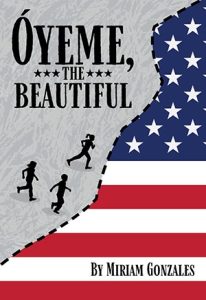
Óyeme, the beautiful by Miriam Gonzales
Laura and Valentina are just trying to make it through another day in middle school. However, unlike many of their peers, they are refugees from Central America who have fled brutal violence in their home countries to find shelter and pursue their dreams in the United States.

Beezus and Ramona by Beverly Cleary
Ramona’s sister, Beezus, tries very hard to be patient, but how many nine-year-old girls have to put up with their embarrassing, annoying little four-year-old sisters?
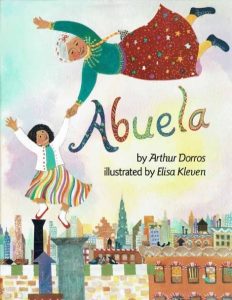
Abuela by Arthur Dorros
While riding on a bus with her grandmother, a little girl imagines that they are carried up into the sky and fly over the sights of New York City.

A Crown for Corina by Laekan Zea Kemp
Corina is excited to wear the biggest crown made with the most beautiful flowers for her birthday, flowers picked from her abuela’s garden that each tell a special story of all the ways Corina is rooted in the family and Mexican traditions she loves.
[/bs_citem]
[/bs_collapse]


